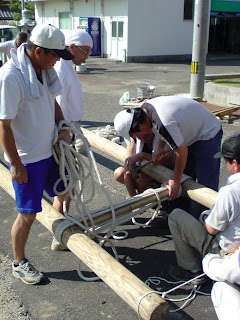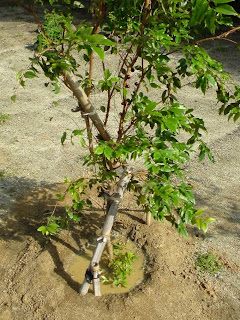SaturdayOn the first evening, it was looking a lot like rain. As the sun went down, it backlit the Takanawa Shrine flags. The flags creak like sails in the wind.

The activities of Saturday night were essentially the same as Sunday night, so I won't bother going into them in detail -- needless to say though, there was beer, noise, exertion and shouting.
SundayThe morning started in Takanawa Shrine following a breakfast of beer and custard-filled bread. The dancing dragon-lion thing was finally tamed in the traditional method with a couple of shots to the head from a musket, whereupon it could be led about quietly.

An exceptionally heavy omikoshi was bounced around the shrine grounds. This monster is an old portable shrine from the days when our area had a bigger, younger population that could bear the weight.


View from the shrine gate

Looks like a question of too much beer too early
After the diabolical entertainments in the shrine, it's time to wheel the danjiri up and down the street. I'm wearing my new black koikuchi pyjamas which my neighbour kindly brought to my house from his workman's clothing shop.


Shortly after this picture was taken, I ducked aside to avoid the corner of a portable shrine that was making straight for my head. Whereupon I experienced an intense crushing, burning sensation that I couldn't quite place. Then I realized that the danjiri had run right over my foot. No harm done, but gosh, your fully laden danjiri is a very heavy thing.

Not that omikoshi are light either. The one that missed me was laden with a young father clutching his baby daughter who was dressed in full festival fig of course.

The sun rises over Takanawa-san in the background
A young lady in boots appeared to watch the danjiri, but she wasn't left in peace for long. A farmer promptly gave her his happi jacket and recruited her to grab a pole. Now as I understand it, for safety reasons, nobody is allowed to ride or manipulate the danjiri unless they're wearing tabi, but it seems exceptions can be made under special circumstances.


When I declared that the little girls looked like a herd of some species of animal, there was a strong and mutinous reaction, but when I showed them this photo, it turned to general agreement.

The morning bash ended and I went home to brush my teeth, weed my garden and gird my loins for the second evening's session.

Now the evening session is quite a business. All of the danjiri from the local districts gather on a wide stretch of road and are pushed together side-by-side in rows of six. While the young folk ride on the danjiri, hammering on bells, thrashing drums, blowing whistles and waving batons, their ageing parents push on the poles like galley slaves. Some of the older folk, myself included, like to yell 'Yoi-sa!" in time at the top of their lungs until they're hoarse. Then they like to croak impolitely at the womenfolk for beer.

Local teenage girls who normally drift by unnoticed in school uniforms suddenly appear in full make-up with earrings and big smiles.

After the evening bash, there was a solemn ceremony in Takanawa Shrine to invite the god down into the portable god-box. However the solemnity was broken by a series of loud farting noises from the assembled kneeling children. It was hard to tell if the noises were real or feigned, but nevertheless they produced uncontrollable giggles. The adults did their best to suppress the hilarity by saying things like "If you keep that up you'll really shit yourself" and "Cor, that was a nasty one". It seems as though the Shinto aspect of the festival is not treated with great respect by all parties, and at one point I noticed that the younger kaminushi or 'god master' was getting seriously riled by his parishioner's lack of piety.

The little ones were not still for long
The next morning, Monday, we were up at a leisurely 7:30 for a breakfast of beer, sake, and horrible little dried fish at the shrine. The sake tasted pretty good as a change after all the beer. We set off from the shrine singing the shrine-carrying song, a nice call and response ditty which extols the virtues of our region. I have the melody down better than most of my neighbours and received some joshing about stealing the limelight -- "Roddo bakkashi yan".

The region is certainly worthy of songs of praise
We carried the shrine here and there to different people's houses and were treated to more beer and some rather good snacks.

Farmers, men of industry, and salesmen

The view from the roof of the wedding hall

Of course, after three days of drinking beer from dawn till dark, hauling danjiri and omikoshi along flag adorned streets, these heavy articles have to be disassembled and put away carefully in storage for next year. This can seem a bit of a fag. A pleasant meal and more beer is served after the work is done.

The last picture is one I took on my way home on Monday evening. Like the strips of land, I felt like I was suspended in space, and my thoughts, such as they were, mirrored the wispy clouds. Home, to an early bed.
 Tuesday
TuesdayIt appears that the shock of getting up on Tuesday and not drinking several bottles of beer before 7 am has undermined my constitution. I have a terrible cold and my hips don't seem to be functioning properly at all.
 I've been wanting to do something about it for a while, and I've been gradually cutting out the dead wood from the moso grove to make charcoal with. Recently, having decided to complete my bamboo fence with the easily manageable madake, I began to tackle the dead wood. Hacking it into pieces with my bill-hook/machete thing is a very violent activity, and showers of rotten bamboo come crashing down from on high. Luckily, most of it is pretty light so it doesn't hurt much if it lands on your head.
I've been wanting to do something about it for a while, and I've been gradually cutting out the dead wood from the moso grove to make charcoal with. Recently, having decided to complete my bamboo fence with the easily manageable madake, I began to tackle the dead wood. Hacking it into pieces with my bill-hook/machete thing is a very violent activity, and showers of rotten bamboo come crashing down from on high. Luckily, most of it is pretty light so it doesn't hurt much if it lands on your head. By the time I've smashed up great swathes of dead wood and cut out the mature culms that I want for my fence, it's generally too dark to stack the cuttings tidily. But unless I do that, the new growth will no doubt be as twisted as ever. So I guess at least part of the New Year holidays will be spend sorting and stacking dead sticks.
By the time I've smashed up great swathes of dead wood and cut out the mature culms that I want for my fence, it's generally too dark to stack the cuttings tidily. But unless I do that, the new growth will no doubt be as twisted as ever. So I guess at least part of the New Year holidays will be spend sorting and stacking dead sticks.
















































